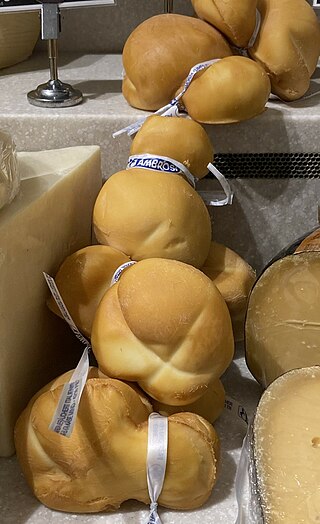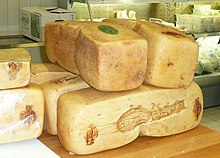
Mozzarella is a semi-soft non-aged cheese prepared by the pasta filata ('stretched-curd') method with origins from southern Italy.

Curd is obtained by coagulating milk in a sequential process called curdling. It can be a final dairy product or the first stage in cheesemaking. The coagulation can be caused by adding rennet, a culture, or any edible acidic substance such as lemon juice or vinegar, and then allowing it to coagulate. The increased acidity causes the milk proteins (casein) to tangle into solid masses, or curds. Milk that has been left to sour will also naturally produce curds, and sour milk cheeses are produced this way.

Caciocavallo is a type of pasta filata ('stretched-curd') cheese made out of sheep's or cow's milk. It is produced throughout southern Italy, particularly in the Apennine Mountains and in the Gargano peninsula. Shaped like a teardrop, it is similar in taste to the aged southern Italian provolone cheese, with a hard edible rind.

Kashkaval is a type of cheese made from the milk of cow's, sheep's, goat's or mixture thereof. In Albania, Bulgaria, Kosovo, North Macedonia, Romania and Serbia, the term is often used to refer to all yellow cheeses. In English-language menus in Bulgaria, kashkaval is translated as 'yellow cheese'.

Cheesemaking is the craft of making cheese. The production of cheese, like many other food preservation processes, allows the nutritional and economic value of a food material, in this case milk, to be preserved in concentrated form. Cheesemaking allows the production of the cheese with diverse flavors and consistencies.

Provolone is an Italian semi-hard cheese made from cow's milk. It is an aged pasta filata ('stretched-curd') cheese originating in the Campania region, near Vesuvius, where it is still produced in pear, sausage, or cone shapes 10 to 15 cm long. Provolone-type cheeses are also produced in other countries. The most important provolone production region today is northwestern Italy and, in particular, the city of Cremona. Provolone, provola, and provoleta are versions of the same basic cheese. Some versions of provolone are smoked.

Dolcelatte is a blue veined Italian soft cheese. The cheese is made from cow's milk and has a sweet taste.

Akkawi cheese is a white brine cheese named after the city of Akka.

Bocconcini are small mozzarella cheese balls. Like other mozzarellas, they are semi-soft, white, and rindless unripened mild cheeses that originated in Naples and were once made only from the milk of Italian Mediterranean buffalo. Nowadays, they are usually made from a combination of buffalo and cow's milk. Bocconcini are packaged in whey or water, have a spongy texture, and absorb flavors.

Morlacco or Morlacco del Grappa is an Italian cow's-milk cheese from Monte Grappa, in the provinces of Vicenza, Treviso, and Belluno), where cheesemakers once produced a soft cow's milk cheese, low in fat, with an uncooked curd that was named after their native region: Morlachia.

Scamorza is a southern Italian cow's milk cheese. It can also be made from other milks, but that is less common. It is a pasta filata ('stretched-curd') cheese, in which the fresh curd matures in its own whey for several hours to allow acidity to develop through the conversion of lactose to lactic acid. Artisanal cheese makers generally form the cheese into a round shape, and then tie a string around the mass one third of the distance from the top, and hang it to dry. The resulting shape is pear-like. This is sometimes referred to as "strangling" the cheese. The cheese is usually white unless smoked. When smoked, the color is almond with a lighter interior.

Stracciatella di bufala is a cheese produced from Italian buffalo milk in the province of Foggia, located in the southern Italian region of Apulia, using a stretching and a shredding technique.

Pasta filata is a technique in the manufacture of a family of Italian cheeses also known in English as stretched-curd, pulled-curd and plastic-curd cheeses. Stretched curd cheeses manufactured using the pasta filata technique undergo a plasticising and kneading treatment of the fresh curd in hot water, which gives the cheese its fibrous structure.

Caprino is an Italian cheese traditionally made from whole or skimmed goat's milk. The name of the cheese derives from the Italian word for goat, capra. With modern methods of production, the cheese is made from cow's milk as well or a combination of both cow's and goat's milks. The two major styles of caprino are fresco ("fresh") and stagionato ("aged").

There are many different types of cheese. Cheeses can be grouped or classified according to criteria such as length of fermentation, texture, methods of production, fat content, animal milk, and country or region of origin. The method most commonly and traditionally used is based on moisture content, which is then further narrowed down by fat content and curing or ripening methods. The criteria may either be used singly or in combination, with no single method being universally used.

The pallone di Gravina is a firm, semi-hard, cow's milk cheese from the regions of Basilicata and Apulia, in south-east Italy. It is made in the pasta filata style weighing between 1.5 and 2.5 kg, in a pear-like shape, ball or balloon (pallone), and was traditionally produced in the area of the city of Gravina, in the Murgia area of the province of Bari. Today, however, production is centred on the province of Matera.

Stracciata is a fresh pasta filata cheese produced in Italy. Stracciata is formed into flat strips of about 4–5 cm wide, 1 cm thick and folded in on itself in a uniform manner or woven wire, made with cow's milk. The name stracciata means "tattered" in Italian.
Provola silana is a variety of cheese typical of the Sila area, in the Calabria region of Italy.
















